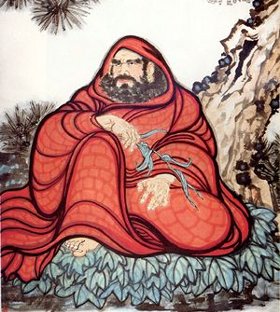Freeing oneself from words is liberation.
As mortals, we’re ruled by conditions, not by ourselves.
As long as you’re subject to birth and death, you’ll never attain enlightenment.
As long as you look for a Buddha somewhere else, you’ll never see that your own mind is the Buddha.
Life
Birth: Bodhidharma was born in Kanchi in the Southern Indian kingdom of Pallava around year 440.
Realization: After the death of Bodhidharma’s father, Bodhidharma went to Prajnatara, the 27th Indian patriarch in succession from Buddha, and requested ordination as a monk. Where Bodhidharma eventually awaken.
Death: Bodhidharma’s death has occurred prior to 534, at the banks of the Luo River.
Teaching Style: After Bodhidharma’s eventual awakening, his teacher Prajnatara told him that he should go to northern China, where he would find successors Bodhidharma followed the suggestion, crossing the Yangtze River into northern China and arriving at the Shaolin monastery, where he started teaching and taught for several years and developed many disciples.
Fame: Bodhidharma was South Indian Tamilian and was a Pallava prince from the kingdom of Kanchipuram, the third son of King Sugandha. He got the name Bodhidharma by his Indian teacher Prajnatara. Bodhidharma was the Buddhist monk traditionally credited as the transmitter of Zen to China. At the instruction of Prajnatara (His teacher) he traveled to China by ship and arrived around 475. He is associated with the Shaolin temple, and is honored as the founder of kung fu. He is also credited with bringing tea to China. He is said to have cut off his eyelids to stay awake in meditation, and so is usually depicted with bulging eyes. He is also credited with bringing Zen to China, even though he had few disciples in his lifetime. For nine years he had remained and nobody knew him; carrying a shoe in hand
Legacy: Bodhidharma is said to have been a disciple of Prajnatara. The Yi Jin Jing credits Shaolin Kung Fu to Bodhidharma, which would make him an important influence on Asian martial arts. He attracted many disciples, specifically mentioning Daoyu and Huike, the latter of whom would later figure very prominently in the Bodhidharma literature. He was the 28th Patriarch of Buddhism in a line of descent from Sakyamuni Buddha via his disciple Mahakasyapa, and the first Patriarch of Chan:
Teachings
Bodhidharma is associated with the idea that spiritual, intellectual and physical excellence is an indivisible whole necessary for enlightenment.
He told that “As long as you’re subject to birth and death, you’ll never attain enlightenment. To attain enlightenment you have to see your nature. Unless you see your nature all this talk about cause and effect is nonsense.”
According to him “The mind’s capacity is limitless, and its manifestations are inexhaustible. Seeing forms with your eyes, hearing sounds with your ears, smelling odors with your nose, tasting flavors with your tongue, every movement or state is your entire mind. At every moment, where language can’t go, that’s your mind.”
He told that “Whoever knows that the mind is a fiction and devoid of anything real knows that his own mind neither exists nor doesn’t exist. Mortals keep creating the mind, claiming it exists. And arhats keep negating the mind, claiming it doesn’t exist. But bodhisattvas and Buddhas neither create nor negate the mind. This is what’s meant by the mind that neither exists nor doesn’t exist.”


One never has what one never got..so if we are here for every moment that brings us here once again it is because of the existance of what is here is with us….and that basically is nothing…we are just complete of the void which the void has been full of empty…enjoy of what is and that is all…(+)
Dom*:)
nice One
Check My Blog Kanchipuram Portal